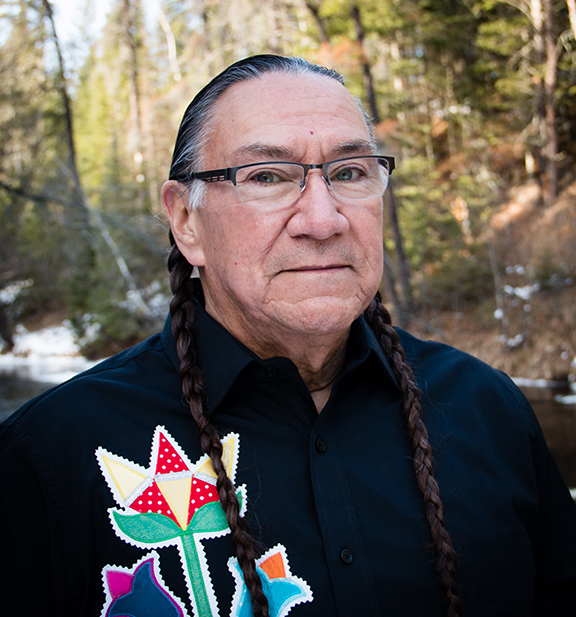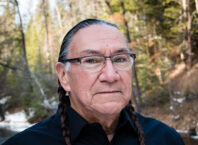By Arne Vainio, MD
Seattle is a beautiful city and was a great place to do my residency. I spent 3 years at the Seattle Indian Health Board and Providence Hospital and have many stories from there.
This is one of them.
Harold lived alone with his dog, Albert. Albert was a big, happy, slobbery dog who loved riding in the car with Harold. He had his head out the window with any chance he had. It was clear that in his eyes Harold could do no wrong. Harold hardly ever came in to the clinic. I usually saw him when he was in the hospital for pneumonia. I had repeatedly tried to get him to quit smoking, but he never wanted to go to the classes or take the medicines.
In the 3 years I’d been at the clinic, I had admitted Harold 5 or 6 times to the hospital for pneumonia (a bacterial infection in the lungs). Two of those times he ended up on a ventilator. His pneumonia was complicated by his smoking and resultant emphysema. Emphysema is a breakdown of the air sacs in the lungs, making it hard to get oxygen. It’s a chronic condition with no cure. It’s almost always caused by smoking, and preventing it is the only real solution.
In addition to this, he had lymphoma, which is a cancer of his lymph nodes (part of the immune system) about 10 years earlier. This had been treated with chemotherapy, but he never went back to make sure it was cured. But every time he got pneumonia, he became very worried about his lymphoma coming back.
I ended up doing multiple CT scans on him during his pneumonias. Except for his worsening emphysema, these always came out OK. According to the Pulmonologist (lung specialist) I referred him to, continuing to smoke put him at an extremely high risk of getting lung cancer.
About 6 months before I finished residency, he was in the hospital again for pneumonia. This time his chest x-ray showed a worrisome area in his left lung. A CT scan showed this to be likely cancerous.
He was sent to the Pulmonologist and had a bronchoscopy done. This is a procedure in which a camera on a thin tube is passed into the lungs through the mouth. A biopsy (tissue sample) was taken, and this was positive for lung cancer. He refused to consider surgery and wished to try other options.
He started chemotherapy, but became very sick from it and was unable to finish. There are many types of chemotherapy, usually combinations of medicines based on exactly which type of cancer is diagnosed.
Chemotherapy works by going after rapidly dividing cells. This means it can attack the cancer, but other cells in our bodies are rapidly dividing, including gut, bone marrow and hair. This is why chemotherapy patients can get nausea, weakened immune systems and hair loss. He was given Morphine for his cancer pain and quickly started to abuse it. He ended up in the hospital twice with overdoses of Morphine.
By this time he was getting thinner and had lost almost 85 pounds. Even the skin on his face hung down in leathery folds. Subsequently, he was started on radiation treatment. Multiple treatments of radiation are targeted to the area of cancer. This caused scarring of his esophagus (swallowing tube) and he had a very hard time swallowing. He kept losing weight, but he continued to smoke.
I didn’t see him again for several months as he refused to come in for clinic visits, although he did see the cancer specialists off and on. He was admitted to the hospital again, this time for back pain. X-rays showed that his cancer had spread to his spine, and a bone scan showed it spread to scattered areas of his spine and pelvis.
His cancer was widely metastatic (spreading) and he went home with hospice care to spend his last days with Albert as there were no treatment options left. I left Seattle for Minnesota before I found out what happened to him, but his condition was terminal. I hoped one of the hospice nurses found someone to adopt Albert, but he was an old dog and totally dedicated to only Harold. If he did have to be put down, I took comfort in believing they were together again and driving with the windows down.
Lung cancer is the leading cause of cancer death in both men and women in the USA. There are 175,000 new cases per year in the USA. There are 2 major types, small cell and non-small cell lung cancer. About 80% of new cases are non-small cell and 50% are metastatic (spreading) by the time of diagnosis. This is the most common cancer worldwide. Age 50 to 70 is the most common age and smoking is involved in 87% of cases.
According to the American Indian Community Tobacco Project – www.aictp.umn.edu – 3 out of every 5 American Indian adults smoke, and nearly 2 out of every 5 American Indian deaths are due to cigarette smoking and breathing secondhand smoke. Teens whose family members smoke are 3 times more likely to smoke themselves.
Question: So what do we do about this?
Answer: Prevention!
Anyone seeing a pattern here? We need to keep our kids from smoking, and we need to continue to get current smokers to quit. This is a very difficult problem as nicotine changes receptors in the brain so they only work when nicotine is present. This is why smokers need to have their “fix” and why people can get so crabby when they try to quit. Using patches and gum help by giving a decreasing dose of nicotine over time. There are medicines to help with cravings, there is a new medicine out that blocks the nicotine receptors in the brain. Hypnosis and acupuncture are also helpful (with no side effects). All of these should be in combination with counseling. Quitting with a partner also helps.
Smokers can ask for help to quit. Ask for help at your clinic or by calling 1-888-354-PLAN.
Again, from AICTP: We’ve survived too much as a people to allow ourselves to be conquered by cigarettes.
Look around. Our kids tend to do what we do. Don’t let smoking be one of them.
Arne Vainio, M.D. is an enrolled member of the Mille Lacs Band of Ojibwe and is a
family practice physician on the Fond du Lac reservation in Cloquet, Minnesota. He can be contacted at a-vainio@hotmail.com





